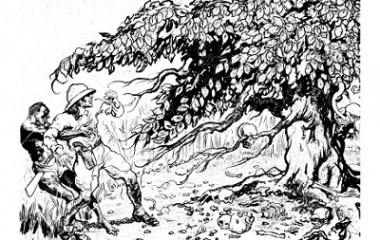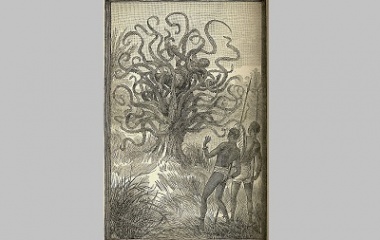What is a Man-eating Tree?
A Man-eating Tree is a vicious predator, usually found deep within jungle territory. Although these trees might look harmless, power courses from their roots to their wild branches. They pose a mortal threat to any warm-blooded creature who mistakes their open arms for shelter, instead of a trap.
Characteristics
Physical Description
Explorers have described several species of Man-eating Trees, each of them taking on an appearance of its own. Sometimes they have rich fruit and flowers; sometimes they stand naked and ominous. Sometimes, they are the tallest tree for miles around, and other times, they grow like short, stocky bushes.
The hallmarks of the Man-eating tree are its snakelike branches, which may be weaving around in the air even when there is no wind blowing, and an absence of life around the tree. Other plants are usually repelled by the tree, so a small clearing may have formed around its base. Animals who approach the tree rarely live to tell the tale, so there are no bird nests, squirrels, monkeys, or other tree-creatures making a playground of its branches.
Special Abilities
Although deadly, Man-eating trees are not particularly refined in their predatory technique. Since their roots keep them firmly planted in the ground, hunting is out of the question. Instead, they wait, like spiders in a monstrous web, for their prey to stumble upon them. They are incredibly sensitive, able to detect a creature as light as a bird perching on one of their branches, and they may be able to detect vibrations in the air and earth even before their prey touches them.
When it’s time to attack, the monsters lash out with their tentacle-like branches, seizing their prey and breaking bones or strangling them by the neck. Some trees are also equipped with suction-cup mouths or leaves, which can tear flesh from their victims. It’s not clear how the carnivorous trees digest their prey. Some explores have suggested that they only drain the blood from their victims, then toss away the body’s shell, while grislier accounts describe victims being incorporated into the body of the tree itself.
Famous Man-eating Trees
Madagascar Tree
In 1874, a German explorer named Carl Liche traveled to Madagascar where, among other terrifying jungle creatures, he encountered a carnivorous tree that was revered by native tribes. Liche wrote a gruesome report of a woman being sacrificed to the tree, a tall monster with serpentine branches that moved lightning fast and strangled victims, in the same fashion as an anaconda. In 1914, another explorer, Chase Osborne, corroborated Liche’s story. Although he himself couldn’t find the tree, tribal people and local missionaries confirmed its existence.
Nubian Tree
In 1881, Phil Robinson pieced together a book of his uncle’s experiences in Nubia, a region of northern Africa, near the Nile River. One of the most horrific monsters in this book was the Nubian Tree, which lured animals into its branches with aromatic flowers and golden fruit that look like large drops of honey. Dew dropped from the tree’s leaves continuously, feeding a screen of rich green grass, which grew as tall and sharp as swords. The tree seized prey with its branches and was impervious to attack by guns and knives.
Ya-Te-Veo
In 1887, JW Buel’s recounted a carnivorous tree that he had encountered in Central and South America. The tree had a short trunk and long branches with saw-like edges. The trees branches lay across the ground until prey approached. Then, they seized the prey and lifted it into the air. Once the poor creature had been drained of blood, its body was cast away.
Cultural Representation
Origin
Throughout history, a number of trees have cropped up to menace innocent men. In Homer’s Odyssey, a lotus tree casts an enchantment over an isolated island. Its delicious fruit caused men to lose their memories and sink into a pleasant drowsiness. Again, in the Bible, the Tree of Knowledge spelled disaster for Adam and Eve when they were tempted to eat its luscious fruit.
Still, the first tree to launch an outright attack on man was the Madagascar Tree, described by an explorer in 1874. The story of the Madagascar tree was followed up with a flurry of other Man-eating Trees, but they fell out of popularity, along with explorer narratives, around the 1920s.
Modern Usage
Today, when explorer narratives are long gone, Man-Eating Trees have experienced a revival in fantasy novels. In Harry Potter, the heroes are attacked by two deadly plants: the Whomping Willow and Devil’s Snare, which was named after a plant described by an explorer in Nicarauga. In The Life of Pi, Pi lands on an island full of carnivorous plants, and in the horror film Little Shop of Horrors a talking, carnivorous plant is tended to by the shopkeeper.
Explanation
Most historical accounts of Man-eating trees have been spectacularly debunked. For example, the Madagascar Tree and the Nubian Tree were not only fake, the “explorers” who discovered them were fake as well!
If Man-eating Trees do exist, hidden in some dark jungle pocket, science has yet to sniff them out. Humans, with their chainsaws and greed, pose a much greater threat to the gentle giants who make up a forest.
Still, carnivorous plants are not just the stuff of sci-fi. They consume hundreds of insects, frogs, and rodents every year! The largest carnivorous plant is the Giant Montane Pitcher Plant, which grows, with its mouth open to the sky, in the mountains of the Phillipines . These pitcher plants are capable of eating rodents as large as rats, but they resemble flowers more than trees, and they use slow-working acids instead of lightning-quick branches to devour their prey. The Venus Fly Trap, a North American cousin of the pitcher plant, has more star power, with its toothy mouth that can be watched as it closes on unlucky insects. These little stars are completely harmless to humans, but their grip on our imagination might have spurred on the “explorers” who dreamed up Man-eating trees.









